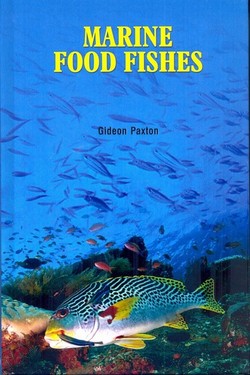641.6

Marine Food Fishes
By
Gideon Paxton
Preface
Some 300.000 marine species are known to scienceــــabout 15 percent of all the species identified on the planet. But the sea is so vast that a million or more as yet unknown species may live in its waters. Most of these aquatic species are tied together through the food web.
Most tropical food fish have higher growth rates than temperate fish species, reaching commercial size much faster. There is a growing demand for marine food fish in all Pacific Island countries, and the supply usually does not meet this demand. There are number of suitable sites for marine finfish culture in the Pacific, and broodstock is locally available in most countries. Some species of food fish have considerable traditional customary values associated with them. Marine finfish is a highly prized commodity in most domestic markets in the pacific.
The marine food chain is made up of animals that feast on the sea̕ s abundant plant life. On the ocean̕ s surface waters, microscopic animalsـــــzooplankton, which include jellyfish and the larval stages of some fish, barnacles, and mollusksـــــdrift across the sea. Grazing opportunistically. Larger herbivores include surgeonfish, parrotfish, green turtles, and manatees.
Forage fish are small fish that travel in large groups called ˈschoolsˈ and are a food source or ʽforageʼ for larger fish and marine mammals. Forage fish, including Pacific sand lance and surf smelt from the cornerstone of marine food webs. They, and other forage fish species play an important role in the diets of Humpback Whales, Porpoise, sea Lions, Seals, Salmon and marine birds.
Seafood is any from of sea life regarded as food by humans. Seafood prominently includes fish and shellfish. Shellfish include various species of molluscs, crustaceans, and echinoderms. Historically, sea mammals such as whales and dolphins have been consumed as food, though that happens to a lesser extent in modern times.
Fish are consumed as food by many species, including humans. It has been an important source of protein and other nutrients for humans throughout recorded history. In culinary contexts, the term fish can also include shellfish, such as molluscs, crustaceans and echinoderms. English does not distinguish between fish as an animal and the food prepared from it, as it does with pig vs. park or cow vs. beef. Some other languages do, as in the Spanish peces versus pescado. The modern English word for fish comes from the Old English word for fish comes from the Old English word fics (plural: fiscas) which was pronounced as it today. English also has the term seafood, which covers fish found in the seas and oceans as well as other marine life used as food.
Contents
1 – Introduction
2 – Fish as Food
3 – Forage Fish
4 – Deep Sea Fish
5 – Coral Reef
6 – Reef Marine Fisheries
7 – Blast Fishing and Types of Operations
8 – Marine Fishing
9 – Management of the Marine Fisheries Resources
10 – Fishing and Marine Ecosystems, Biodiversity and Conservation
11 – Freshwater Fish Processing and Products
12 – Quality Assessment and control of Fresh Fish
***For more please Visit the Library***
Prep. /Ayman Ashry
Manage. / Mona Mahmoud



ساحة النقاش